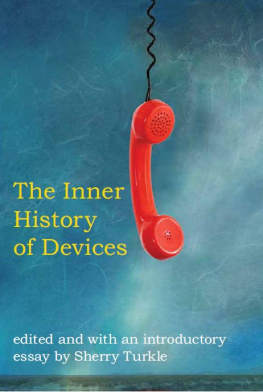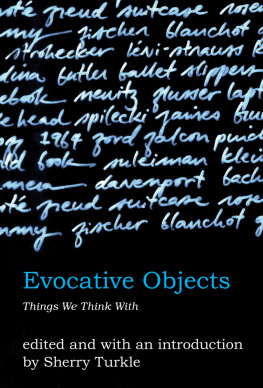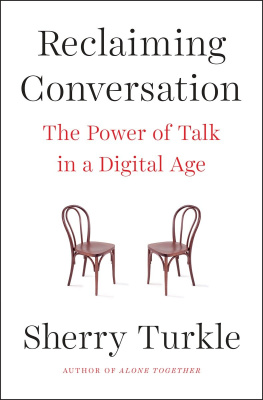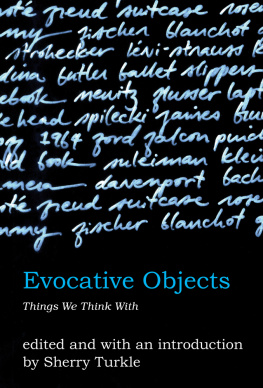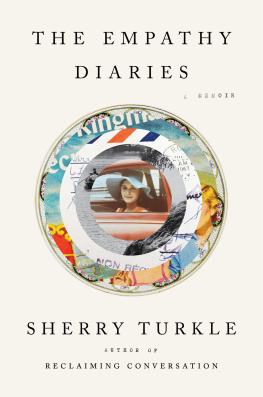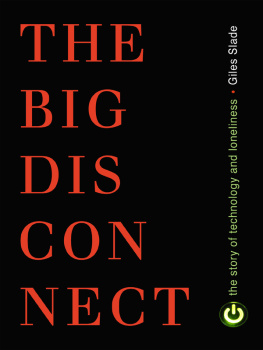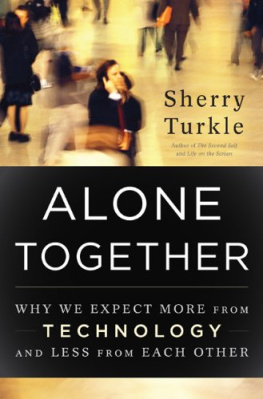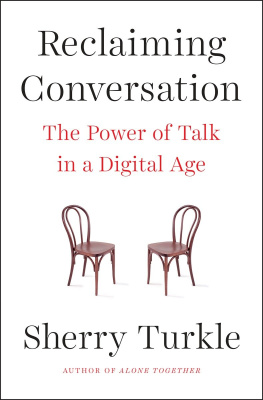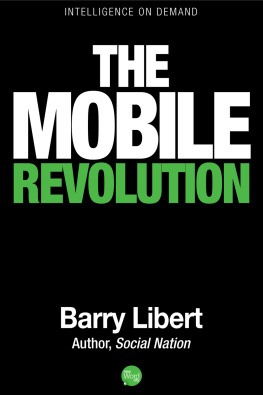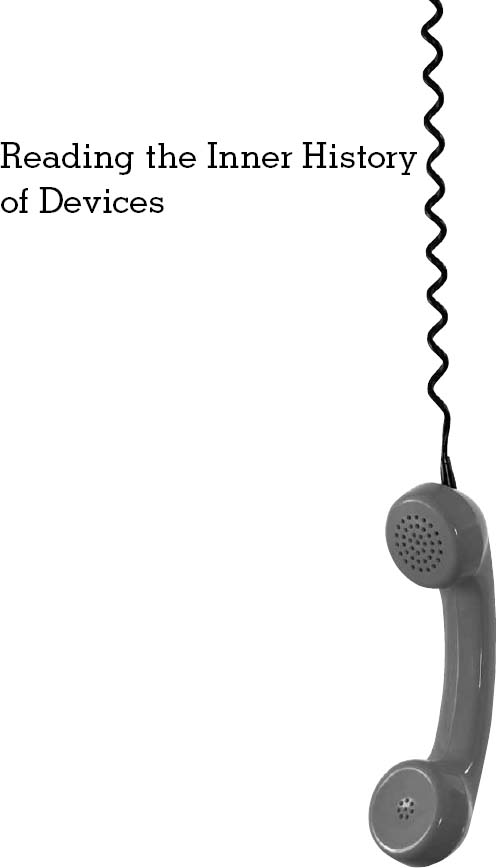
The Inner History of Devices
The Inner History of Devices
edited and with an introductory essay by Sherry Turkle
Tshe MIT Press Cambridge, Massachusetts London, England
2008 Massachusetts Institute of Technology
All rights reserved. No part of this book may be reproduced in any form by any electronic or mechanical means (including photocopying, recording, or information storage and retrieval) without permission in writing from the publisher.
For information about special quantity discounts, please email special_sales@mitpress.mit .edu.
This book was set in Bookman Old Style, ITC Bookman, and Stymie by Graphic Composition, Inc., Bogart, Georgia.
Printed and bound in the United States of America.
Library of Congress Cataloging-in-Publication Data
The inner history of devices / edited and with an introductory essay by Sherry Turkle.
p. cm.
Includes bibliographical references and index.
ISBN 978-0-262-20176-6 (hc : alk. paper)
1. TechnologyPsychological aspects. 2. Medical technology Psychological aspects. 3. ComputersPsychological aspects.
4. InternetPsychological aspects. I. Turkle, Sherry.
T14.5.I5643 2008
303.483dc22
2008005530
10 9 8 7 6 5 4 3 2 1
To Harriet Turkle and Mildred Bonowitz
Contents
Acknowledgments
READING THE INNER HISTORY OF DEVICES
Inner History | Sherry Turkle
THROUGH MEMOIR
The Prosthetic Eye | Alicia Kestrell Verlager
Cell Phones | E. Cabell Hankinson Gathman
The Patterning Table | Nicholas A. Knouf
Television | Orit Kuritsky-Fox
THROUGH CLINICAL PRACTICE
The World Wide Web | John Hamilton
Computer Games | Marsha H. Levy-Warren
Cyberplaces | Kimberlyn Leary
THROUGH FIELDWORK
The Internal Cardiac Defibrillator | Anne Pollock
The Visible Human | Rachel Prentice
Slashdot .org | Anita Say Chan
The Dialysis Machine | Aslihan Sanal
Video Poker | Natasha Schll
Notes
Index
Acknowledgments
In my teaching, I am often asked what stands behind an ethnography alert to the inner life of its subjects. When students press me for guidance, perhaps a list of questions, I tell them that intimate ethnography is not advanced by a particular agenda, but through creating a space to listen. The questions we ask in an intimate ethnography of deviceshow do people feel about the objects in their lives? how do relationships form around them?are common to many ethnographic traditions. Intimate ethnography explores the many ways that the first answers to these questions are not the last answers. It attends to untold stories. People have a received wisdom about themselves, a kind of company line about their lives. To get beyond these, it is helpful to infuse ethnography with other disciplines of self reflectionspecifically, the sensibilities of the clinician and the memoirist. This book grew out of my efforts to answer my students questions about methodology. I thank them for both inspiring and contributing to it.
My conversations with students about technology and the inner life have most recently taken place in the workshops, seminars, and classes of the MIT Initiative on Technology and Self. There, the close study of objects gives memoir and psychodynamic thinking a role in the training of social scientists. I founded the Initiative in 2001, and I thank the Mitchell Kapor Foundation for making it a reality, and the Kurzweil Foundation, the Spencer Foundation, the National Science Foundation, and the Intel Corporation for making it possible for it to continue its work.
This book is the third in a series that has grown out of work at the Initiative. I thank all who have participated in its programs, with a special debt to my students in the Initiative courses Things and Thinking and Science, Technology, and Memoir. This volume draws on the research program funded by the Spencer Foundation on Adolescence, Technology, and Identity and that of the Intel Corporation on Nurturant Technology as well as on the hard work of several Initiative working groups, including Psychoanalysis and Digital Culture; Body Technology; and Information Societies, Technologies and Self. My academic department at MIT, the program in Science, Technology, and Society, has made a good home for all of these endeavors.
In addition, I thank those research associates at the Initiative who worked to shape this book: Olivia Dast, Anita Say Chan, Robert Briscoe, and Will Taggart. Kelly Gray, as in other publication projects at the Initiative, was decisive in helping this book reach for better ideas as well as greater elegance and clarity. During the writing of this book, I craved the time and the tranquility that can only come from a smooth-running professional life. Here I thank Claire Baldwin, Grace Costa, Michele Crews, Trude Irons, and Judith Spitzer. Ms. Spitzers eye for detail was a great friend to this book. At the MIT Press, special thanks to Deborah Cantor-Adams, Erin Hasley, Colleen Lanick, Alyssa Larose, and Robert Prior.
My daughter Rebecca has grown into young womanhood as this collection matured. Readers will be much helped by the consistency of her remarks as I worked at the kitchen table. Every time Rebecca said, No one will know what that means, her academic mother looked long and hard at a particular phrase of well-loved jargon. Additionally, it must be said that Rebeccas proofreading skills are the stuff of legend. Thank you, Rebecca, for this and everything else.
My mother was about feelings and communication; my aunt was about ideas and taking commitments through to the end. Trying to bring their messages together inspires my personal and professional life every day. This book is dedicated to their memory.
Boston, Massachusetts
Spring 2008
INNER HISTORY
Sherry Turkle
Thirty years ago, he was holding a TRS-80 home computer and I saw tears in his eyes. This computer means everything to me, he said. Its where I put my hope. I began the interview thinking I would learn something about how computer hobbyists were putting their new devices to work. By the end of the interview, my question had changed: What was there about personal computers that offered such deep connection? What did a computer have that offered hope?
Since then, studying people and technology, I have learned to listen attentively at such moments. The stories I hear usually have little to do with the stated purposes of the technology at hand:
When I listen to my speech synthesizer, I hear it as an inner voice.
I wasnt even sure I had sent that email, until I got your reply. I thought that maybe I had only dreamed sending that message, or fantasized it.
Everything that I was interested in and everything that was important to me was on that Web site.
These three voices, all from this collection, have much in common. They refer to attachments in which technology inhabits the inner life and becomes charged with personal meaning. One voice is from a memoir, one from the clinical notebooks of a psychoanalyst, and the third from the field notes of an anthropologist, an ethnographer. Without attribution, it would be hard to say which is which.
Here I bring together these three traditionsmemoir, clinical practice, and fieldwork or ethnographythrough which such voices emerge. Each tradition suggests a way of listening that adds new dimension to our understanding of how technologies affect our relationships and sensibilities. Each illuminates the subjective side of the technological experience, how what we have made is woven into our ways of seeing and being in the world. Together they enable us to read the inner history of devices.
Next page
